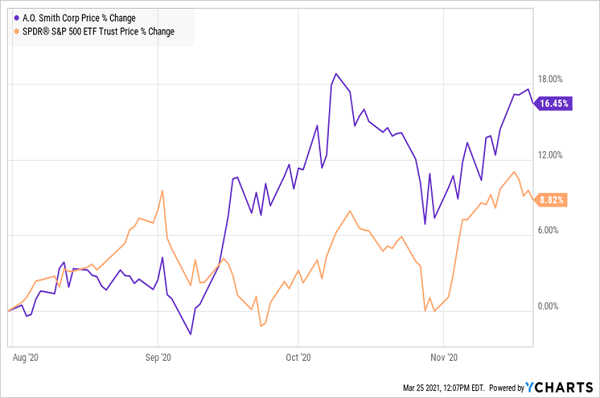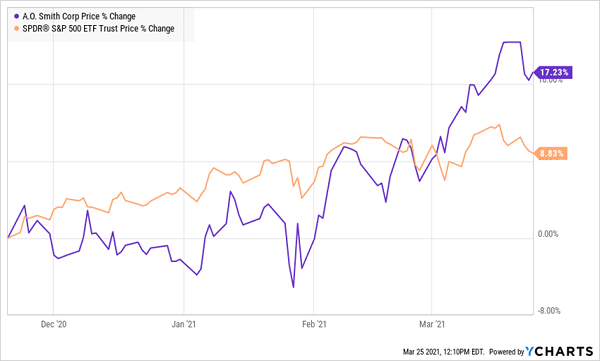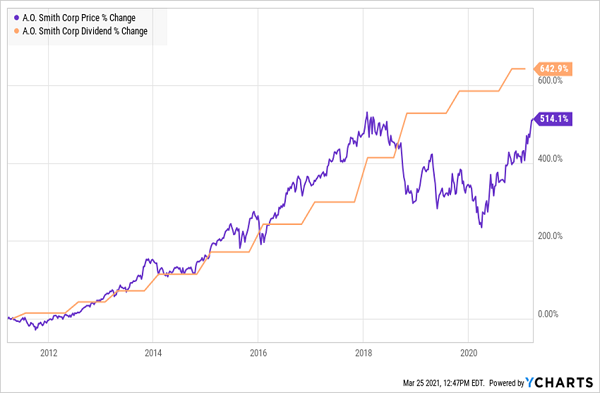Stocks are floating higher and interest rates are spiking. The US recovery is still fragile. Even so, people are being vaccinated fast and the global economy is a coiled spring. Should we take advantage of the current pullback to secure more dividend for our dollar now, while we still can?
I’ve got a two-step dividend-growth strategy for you that’s perfectly suited to this tough-to-predict market.
Step 1: Focus on Dividend Stocks With “Relative Strength”
In a pricey market like this one, it pays to go with dividend-growth stocks showing what I call “relative strength.”
Relative strength means strong stocks tend to stay strong, giving them a solid base from which to jump. Forget the bargain bin—we’re not looking for low P/E ratios here (these days, you won’t find many anyway!)—just stocks with momentum.
Everybody loves betting on a long shot, but the trouble is, these underdogs simply don’t come in enough to pay. We like strong stocks, smart management and megatrends. But everybody wants those, so where do we find our edge?
In two places:
- We find underappreciated stocks in popular sectors. Think: firms with a technology edge that are not—yet!—priced like go-go tech stocks.
- Or we look at an out-of-favor sector and find a stock that has been mislabeled. Real estate investment trusts (REITs) are one example—many people associate them with (dying) shopping malls, but there are many kinds of REITs out there, like cell-tower “landlord” Crown Castle International (NYSE:CCI) or lab owner Alexandria Real Estate Equities (NYSE:ARE).
Smith AO (NYSE:AOS) is a prime example of a stock that nearly everyone has misread. Most people see the Milwaukee-based seller of water heaters as too boring to bother with. In the early months of the pandemic, the investors who did give it a look worried that its commercial business would suffer as industrial clients put off orders.
But I suspected these orders weren’t gone—they’d just get punted into 2021 or 2022. And there was something else going on with the company’s stock last fall. Look at the left side of the chart below—you can see the stock (purple line) bob along for a few weeks, then establish a base and vault past the market (orange line).
AOS Warms Up

With the pattern firmly established, I recommended Smith AO on Nov. 20. It’s gone on to hand us a nice 17% return since, which is nearly double the market’s gain—all thanks to a “boring” water-heater company!
The Power of Buying Relative Strength

Now let’s move on to the second key in our dividend-investing plan.
Step 2: Outrun Rising Rates With Dividend Growers
With the Fed’s money-printing quantitative easing continuing full throttle (and the Biden administration double-dog daring inflation with its $1.9-trillion stimulus package), a jump consumer prices, and an accompanying rise in interest rates, seem likely.
It’s already happening, with the yield on the 10-year Treasury note, pacesetter for rates on everything from credit cards to mortgages, jumping this year.
Higher Rates, Higher Inflation?

Dividend-growth stocks are our go-to as inflation and rates rise—particularly dividend growers that are raising their payouts fast. It only makes sense: most investors are unlikely to favor a Treasury yielding a still-lame 1.6%—and lock up their cash for 10 years in exchange—over a stock growing its payout double digits.
What’s more, quick dividend growth rapidly builds your yield on cost. That can mean that a 2% current yield on a buy made now could grow to 10%+ down the road.
Plus, if there’s one thing I’ve learned over my years of dividend-growth investing, it’s that a stock’s share price almost always tracks its payout growth.
Smith AO again provides a useful example: its dividend tracked its payout higher until mid-2018, when it broke away. It’s bridging the gap again, but it still has a ways to go (the remaining distance is the stock’s upside):
Dividend and Share Price Part Company—for Now

And talk about a high yield on cost: Smith AO yields 1.6% today, about the same as the 10-year Treasury. But that the stock’s 643% dividend growth means investors who bought a decade ago (five years before we launched Hidden Yields) are yielding 9.3% on their original buy. I think you’ll agree that when you’re yielding that much, you don’t have a lot to fear from inflation.
Disclosure: Brett Owens and Michael Foster are contrarian income investors who look for undervalued stocks/funds across the U.S. markets. Click here to learn how to profit from their strategies in the latest report, "7 Great Dividend Growth Stocks for a Secure Retirement."
